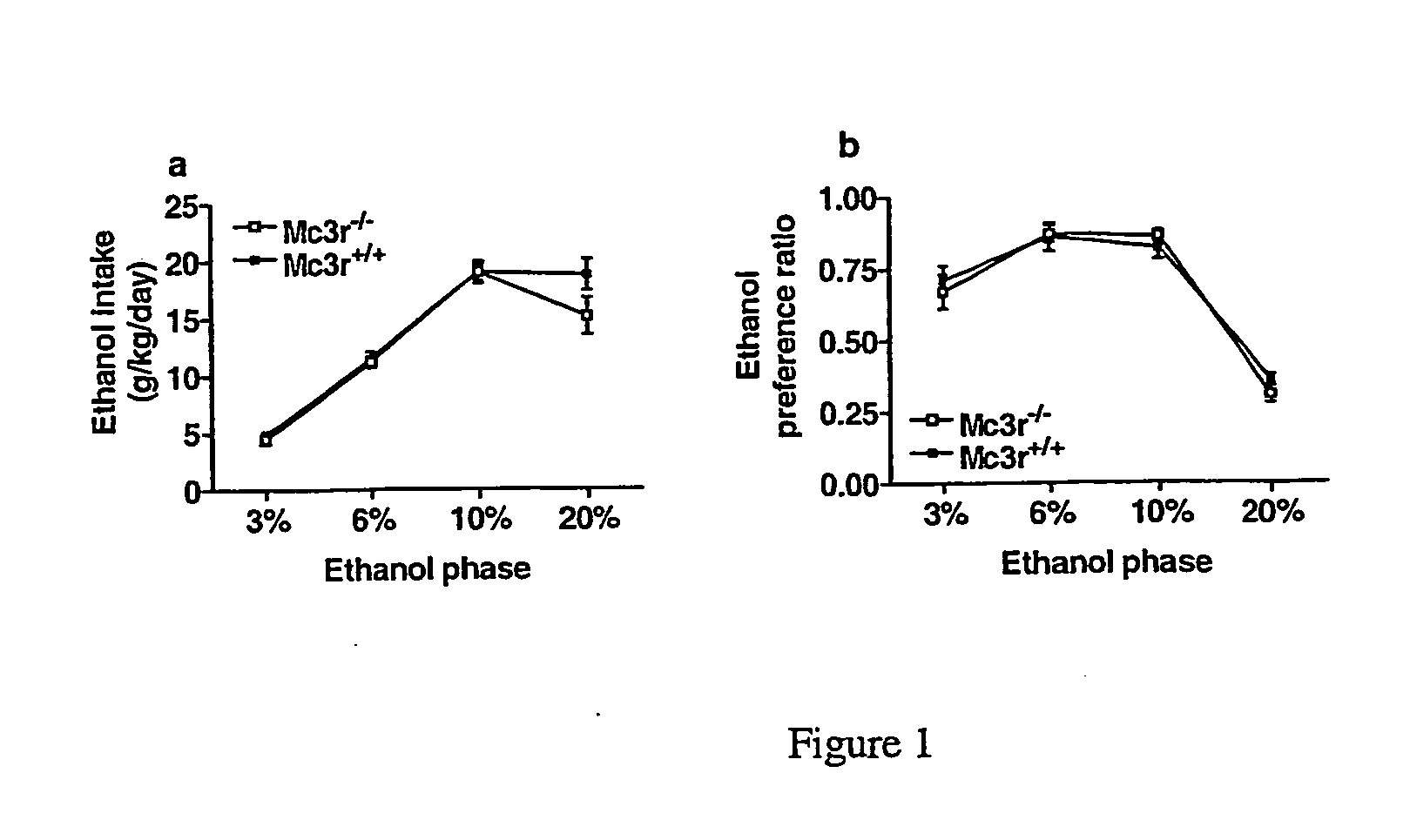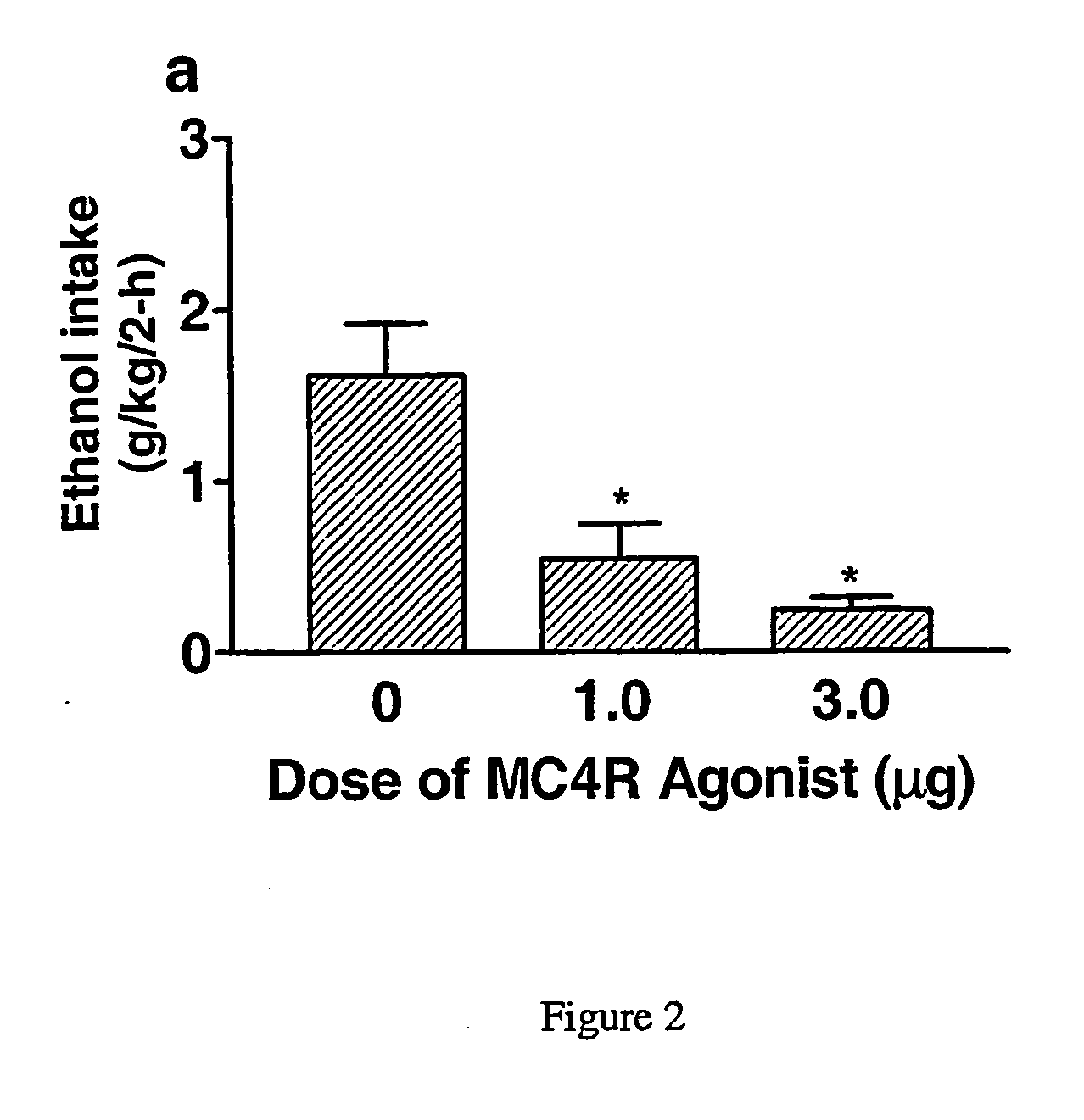Inhibition of voluntary ethanol consumption with selective melanocortin 4-receptor agonists
a melanocortin 4-receptor and ethanol-based technology, applied in the direction of drug compositions, peptide/protein ingredients, metabolic disorders, etc., can solve the problems of impaired control of drinking, alcohol abuse is one of the most significant problems, and the economic cost of alcohol abuse to the united states is estimated to be nearly $150 billion per year, etc., to achieve the effect of reducing alcohol consumption and preventing alcohol consumption
- Summary
- Abstract
- Description
- Claims
- Application Information
AI Technical Summary
Benefits of technology
Problems solved by technology
Method used
Image
Examples
example 1
Materials and Methods
[0111] The peptides of the present invention were evaluated for agonist activity in receptor binding assay. Crude membrane preparations were obtained from Chinese hamster ovary cells expressing human MC3, MC4, and MC5 receptors. Cells were rinsed with phosphate-buffered saline (PBS) lacking CaCl2 or MgCl2 (Life Technologies, Gaithersburg, Md., USA), and then detached with enzyme-free dissociation media (Specialty Media, Lavellette, N.J., USA). Cells were pelleted at 2800×g for 10 minutes and resuspended in membrane buffer (20 mM Tris, pH 7.2, 5 mM ethylenediaminetetraacetic acid) with 5 μg / ml leupeptin, 5 μg / ml aprotinin, 40 μg / ml bacitracin, and 25 μg / m pefabloc (Boehringer Mannheim). The cells were doused with 10 strokes by using a motor-driven Teflon-coated pestle in a glass homogenizer at low speed. The resulting cell suspension was centrifuged at 4100×g, 4° C., for 20 minutes. The pellet was resuspended in fresh membrane buffer ...
example 2
cAMP Assays
Materials and Methods
[0114] Chinese hamster ovary cells expressing a human melanocortin receptor were rinsed with calcium-and magnesium-free PBS (Life Technologies), and detached from the tissue culture flasks by 5-minutes incubation with enzyme-free dissociation buffer (S-014-B, Specialty Media). Cells were collected by centrifugation and resuspended in Earle's balanced salt solution (Life Technologies) with addition of 10 mM 4-(2-hydroxyethyl)-1-piperazineethanesulfonic acid (Hepes) buffer, pH 7.5, 5 mM MgCl2, 1 mM glutamine, and 1 mg / ml bovine serum albumin to concentration of 1-5×106 cells / ml. Subsequently, cells were counted and the cell suspension was treated with the phosphodiesterase inhibitor 3-isobutyl-1-methylxanthine (to concentration of 0.6 mM).
[0115] A test compound was dissolved in dimethyl sulfoxide (DMSO, 10−3 to 10−8 M), diluted with buffer and 0.1 volume of the solution was added to 0.9 volumes of the cell suspension (1 to 5×105 cells); final conce...
example 3
Voluntary Ethanol Consumption
Materials and Methods
[0117] The generation of Mc3r− / − mice has been described (Chen, S. et al., Nature Genetics (2000) 26: 97-102). Mc3r− / − mice are born at the expected frequency and are viable and fertile. Gross anatomical and histological assessment of these mice revealed no abnormalities of brain or other organs; the Mc3r− / − mice have increased fat mass, decreased lean mass, and are hypophagic. Studies described below utilized male and female Mc3r− / − and / or Mc3r+ / + mice of a C57BL / 6J genetic background, 8 to 12 weeks of age at the start of experiment. Non-littermate heterozygous (Mc3r+ / −) mice were bred, resulting in Mc3r− / − and Mc3r+ / +F2 littermate mice. Mice were individually housed in polypropylene cages with wood-chip bedding and had ad libitum access to standard rodent chow (Teklad, Madison, Wis.) and water throughout the experiments except where noted. The colony room was maintained at approximately 22° C. with a 12h: 12h light:dark cycle. ...
PUM
| Property | Measurement | Unit |
|---|---|---|
| pH | aaaaa | aaaaa |
| pH | aaaaa | aaaaa |
| pH | aaaaa | aaaaa |
Abstract
Description
Claims
Application Information
 Login to View More
Login to View More - R&D
- Intellectual Property
- Life Sciences
- Materials
- Tech Scout
- Unparalleled Data Quality
- Higher Quality Content
- 60% Fewer Hallucinations
Browse by: Latest US Patents, China's latest patents, Technical Efficacy Thesaurus, Application Domain, Technology Topic, Popular Technical Reports.
© 2025 PatSnap. All rights reserved.Legal|Privacy policy|Modern Slavery Act Transparency Statement|Sitemap|About US| Contact US: help@patsnap.com



